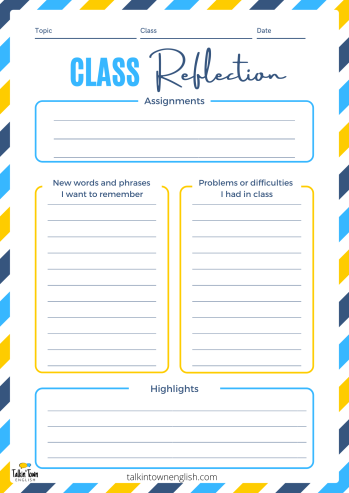The brave new world of cyber study
It certainly does take a world of courage to log in, share screen, and lay out the lesson plan for the future of education. The students and teachers of today must adopt new behaviors if they are to maximize the online learning experience of tomorrow.
This is especially true for second language learners, who are already at a disadvantage without the context, body language, and physical cues they rely on so heavily when interacting in a second language.
So what can students do to maximize online learning? It might sound simple, but taking 3 to 5 minutes to write a daily reflection following each Zoom lesson is one of the most important ways we can boost language acquisition in online learning environments.
The End of Old-School Education
I remember the chaos, the panic, and the frustration of those first few online classes I taught in March of 2020, when a global pandemic unceremoniously removed us from our schools and classrooms. Those early days tested our determination to learn, our will to succeed, and our ability to stay sane… on deeply personal levels.
I’ll never forget the brave group of students who shared that experience with me, even though I’m pretty sure that most of my grammar lessons went right out the virtual window. Who would want to study the second conditional during a worldwide socio-economic collapse? No one.
Now, months later, I’ve finally come to a place of calm composure where I can begin to analyze and measure the effectiveness of various learning techniques within the virtual classroom. While I still have more questions than I do answers regarding best practices in online education, I can confidently offer one piece of advice to all online language learners:
Get in the habit of writing a reflection after every class you attend. It’s one of the best ways to maximize retention of the materials presented for successful online language acquisition.
The End of a Zoom Class
We’ve all been there. That kinetic moment when a Zoom class is about to end. A peppy wave goodbye. A big smile. And then it happens. We click the “End Meeting” button with a triumphant jab and a sigh of relief. Another Zoom class is completed. We shut everything down and return to reality as quickly as possible.

But here’s the thing: that enticing “End Meeting” button is a subconscious trigger for us to shut down our attention and focus as well. We’re instantly transported back to our homes, where real life comes flooding in to consume our thoughts. We might start planning our next meal, catch up on chores and errands, or head out for some much-needed fresh air and sunshine. And while online learning has made life more convenient in many ways, the truth is, when we transition from Zoom to room without any time for refection, we’ve missed an important opportunity.
The Act of recollection
The word “recollect” literally means “to collect again.” The simple act of collecting everything you just experienced in class is a proactive measure to ensure maximum retention of new material. It’s neither a difficult nor painful process, and once you form the habit, it shouldn’t take more than 3-5 minutes of your time.
I’ve organized the reflection process into four parts, which should be completed in a specific order. I’ve also created a free worksheet you can print out to help you get started. Ready to maximize your online learning experience? Let’s go!
Reflecting made simple

Writing a reflection is nothing more than taking a few moments to recall and record key points of a lesson. Here’s how to do it.
When you finish a class, stand up, stretch your legs. Take a 5-minute break. Use the restroom or get a drink. Then, go back to where you were sitting in the meeting, and pick up your pen and a clean sheet of paper or printed template. By the way…
DO NOT TYPE YOUR REFLECTION ON A COMPUTER!
It is absolutely necessary to write your reflection rather than type it out, as studies have shown that handwriting is far superior to typing when it comes to memory retention.

Part 1: What happened
Begin your reflection by recording the date, the topic of the class, and the teacher’s name. Do you know all of your classmates’ names? Knowing other students’ names is part of the learning experience! You want to feel comfortable with your classmates and build relationships with them as you learn together.
Being online doesn’t mean you’re learning alone.
Your classmates are sharing in your learning experience, and learning more about them will help you all grow and learn together. If you are bad at remembering names, there’s no shame in writing a few names down to help you feel more comfortable the next time you want to strike up a conversation.
Jot down any assignments that are due, including homework, essays, or research topics. This is important if you are taking multiple online classes and you need to remember deadlines. Don’t trust your brain to remember everything on its own! We have to give it a little help sometimes. Did you know that the simple act of writing information is often enough to help you remember it? And should that pesky writing assignment accidentally escape your mind, it’s all there waiting for you on paper to remember.
Part 2: What I learned
Next, quickly take note of any new words or phrases you learned that you would like to add to your vocabulary. If you don’t remember the word, try searching for synonyms of that word. Close your eyes and travel back to the moment when that word was used. What topic was being discussed when the word came up? Who was speaking when you heard it?
If you learned something that made a difference to your language goals, write that down, too. Maybe it was a grammar rule that you want to investigate further. Or maybe it was an idiom that you would really love to use in daily conversation. Here’s one:
Much of what we hear in class goes in one ear and out the other.
This idiom implies that listening doesn’t mean learning. Get it all down on paper, so your brain has room for more information to be added.
Part 3: What went wrong
Now for the hard part. Think about all the things that went wrong in class. Were there connection problems? Was there too much background noise during class? Were you unable to express your ideas using language? Was there vocabulary or grammar that you didn’t understand completely? Write it all down.
Don’t worry too much about why these problems occurred. And definitely don’t blame yourself (or your teacher!), because it won’t do you any good to feel bad. It’s more important to acknowledge how those problems negatively affected your class or your mood.

As a teacher, I can tell you that we can’t always have a perfect class. This was true before the pandemic as well. I’ve left classes feeling disappointed, angry, or both. When that happened, I would often find a friend, colleague or loved one to talk to about it. But there are no water coolers in online education. We can’t gather together after class with other teachers or classmates to vent. It’s important, perhaps critical, to get everything off our chests so we don’t carry it into future online classrooms.
Part 4: What went right
Once you’ve unloaded all the baggage from that lesson, you can begin to unpack the gifts. Use the last few minutes of writing to reflect on all the good things that happened in class. Was there a funny moment when everyone laughed? Did the class do well on a difficult grammar exercise? Did you create a perfect sentence, or finally get the pronunciation right on a tricky word? Make a note of the highlights from class.

It’s important to do this step last, because it creates a positive memory of class that will stay with you for future classes. By recording some of the day’s details, you are actively inspiring your brain to hang on to them just a little longer. You may even find that your attention is heightened in future classes, now that you’re looking for things to add to the day’s reflection.
The Takeaway
Distance learning is vastly different from the brick and mortar classrooms we knew and loved. The cold, blue light of a camera screen is nothing like the warm, living glow that a teacher emits in person. The smell of ink filling pages, the sound of pens scratching away on paper, and the ritual of making a daily pilgrimage to places of learning have been replaced by the click-clacking of keyboards, the silence of muted participants, and a daily pilgrimage to another room after class.
The Covid-19 pandemic has forever changed the way we live, work, and learn. Our first hurdle was to learn how to use Zoom for the very first time. We all went from 0 to 60 in what seemed like 48 hours. Our ability to adapt to online learning was nothing short of amazing.
Today, as life goes on despite the constant threat from an invisible enemy, students around the world are presented with brand new, often experimental, systems of learning. Traditional educational models are being checked at the door, like heavy old winter coats.
Research and development of online learning techniques and approaches is more important than ever if we hope to make Zoom classes successful for both teachers and students. Writing a reflection is a simple start to successful online learning, but there are still questions which need answers. There are questions which haven’t even been asked yet!
We’ve proved that it was possible. Now let’s try and make it powerful.
I hope this post finds you safe, healthy, and ready to take on distance learning with everything you’ve got!
I’d love to hear about your personal experiences in online learning, as well as any tips or advice you have for maximizing the online learning experience. Leave me a comment in the thread. 🙂
Teacher Elsa


kelly19751127
Your article helped me to effectively improve my learning methods in the future. thank you very much